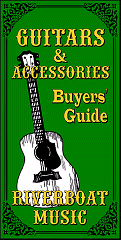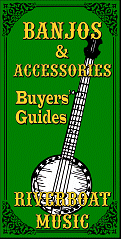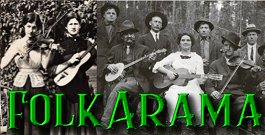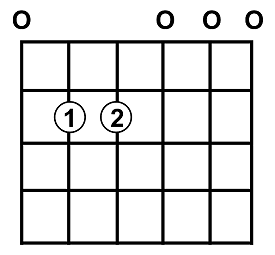
Open New Doors to Your Playing by Adding Minor Chords
| Please Read: How to Help Our Site at No Cost to You - Some of our articles contain recommendations for products we like and vendors we personally trust. Some of those vendors may pay us a very small commission if you click on a link and buy their products. This costs you nothing at all and helps offset the costs of what we do. So if we point you to something you decide to buy later, please make certain you come back through our site and click on the link directly. Thanks. |
| This Site is a Cookie-Free Zone - Except for discussion forums that you have to expressly register for, none of our pages use cookies of any kind. Some of the vendors we link to do, but that won't affect you unless you click on a link to their pages. Your continued use of this page indicates that you agree to our policy. For details, click here. |



|


It's All Relative - Am and Em
This is part of the "VERY Basic Guitar subset of our "How To Folk" articles. In an effort to "jump start" your enjoyment of Folk music and your ability to join in, no matter what instrument you play, we are providing some very basic notes about guitar chords.

 Note: - This is part of the Folkarama page, which is dedicated to helping beginners "get into" Folk music and join Folk communities as easily as possible, with simple articles and links to resources that provide hands-on instruction in traditional acoustic instruments.
Note: - This is part of the Folkarama page, which is dedicated to helping beginners "get into" Folk music and join Folk communities as easily as possible, with simple articles and links to resources that provide hands-on instruction in traditional acoustic instruments.
Folkarama, in turn, contains many references to more extensive articles and resources in Paul Race's CreekDontRise.com site, as well as other related pages.
Previously on "Basic Guitar"
Hopefully, you have already worked your way through these materials:- Meet Your Guitar - a very basic intro to holding, tuning, and picking the guitar.
- Three Magic Chords - a three-part series to introduce enough easy guitar chords to get you started on learning hundreds of 2- and 3-chord songs.
- C and C9 Chord - These chords enable you to play 3-chord songs in G. With the E minor chord we discuss in this article, you'll be able to play even more.
Caveat - In addition to showing you some chords, this page also tells you how they're most often used. Don't feel bad if parts of the content don't make sense the first or third time you read it. Music majors spend tens of thousands of dollars to learn this stuff, and many of them only learn it because they're getting graded on it. Working musicians, on the other hand, get exposed to these principles daily, and - even if they don't study it on purpose - the best of them "get it" eventually.
If you find yourself keeping up with guitar or any other instrument, come back in a few weeks or months and review this stuff again - it will make a lot more sense, and it will help you become a better musician.
Now for the content part of this chapter:
Relative Minors
No, we're not talking about your under-18 neices and nephews. We're talking about chords that are closely related to chords you've learned so far. So closely related, in fact, thay they often substitute for them. Fortunately, the two we're presenting in this article are easy to play.
E Minor - G's Little Sister - This chord is often given as the answer to the question "What's the easiest chord to play on guitar?" And that answer is almost correct.
It's called G's "relative minor" because a song in E minor (Em) will generally have the same key signature (one sharp) as songs in the key of G. Medieval tunes like "Greensleeves" (or "What Child is This?") used to bounce cheerfully between Em and G. Ironically, many modern worship choruses (as of July, 2023) would do the same thing if they were in the key of G.
Because E is the sixth note of a G scale, E minor is often called the "minor sixth" of G. Just throwing that in because you're going to hear that term eventually if you stick with your music - even if you're playing some other instrument.
Try playing a standard G chord, then playing the Em chord shown at the right, then going back. You'll see there's a sense that you're going "down" to something a little bit sadder, then coming back up to where all is sunny and bright.
That said, in most songs that go from G to Em, you don't really feel like Em is a sadder chord than G, because it is used in passing between G and some other chord.
If you know John Denver's "Country Roads," try this:
- Play a G chord and sing the "Almost Heaven" line.
- Play an E minor chord and sing "West Virginia."
- Play D7 and sing "Blue Ridge Mountains."
- Play C (or C9) and sing "Shennandoah".
- Play G and sing "river."
Of course, you can also sing songs that are based in Em. For example, you now know all the chords necessary to sing Paul Simon's "Sounds of Silence."
Em as Substitute for G - Em turns up In many Folk, Country, and Bluegrass arrangements as a substitute for G in the last line, right before you to the D7 that will resolve back to G at the end of the verse.
For example, if you're singing "Amazing Grace" in G, drop to Em on the word "blind," go to D7 on the word "now," and return to G on the word "see."
If you're doing "Will the Circle Be Unbroken in G," try going to Em on the syllable "-waiting." Then go back to G for "sky, Lord," to D7 on "in the," and finally back to G for the last "sky."
Such substitutions work in any key, of course, but it's so easy in the key of G that guitar players do it more often in the key of G than in any other key.
Em as a "minor second" - Sometimes you come across Em when you're playing in the key of D. In such cases, Em is called the "minor second," because E is the second note of the D scale. In most cases, it's a transition chord that is followed by A7,

A Minor - the C Chord's Little Sister - A minor (usually shown as Am) is the other easy-to-play minor chord. A is the sixth note of the C scale, so when you're playing in the key of C, Am is called the "minor sixth" chord, just as Em is the "minor sixth" of G.
A minor can also substitute for C in the same way that Em substitutes for G.
Sometimes you'll come across an Am chord in a song in G. In that case, it's called a "minor 2nd," because A is the second note of the G scale. When it's used this way, it's usually a transition chord that is followed by D7.
Minor Seventh Chords - One important variation of these chords is also worth noting - the "minor seventh" version.
These are minor chords with a note added. On guitar, you actually pick up a finger to play the chord.

In case you wondered, I have finally shown you the easiest chord to play on guitar - this version of Em7.
The notes you added by removing a finger are:
- Em7 adds a D to the Em chord.
- Am7 adds a G to the Am chord.
Best Uses of Minor Seventh Chords - Adding the seventh (a note that doesn't belong in Em or Am) dilutes the chord in a sense; it makes the chord sound softer, in a way. When minor chords are being used as transition chords, the added seventh seems to make the transition even smoother.
That said, they don't always substitute. For example, if going "down" to an Em is important in the song, as it is in, say, "Country Roads," going down to an Em7 will be less effective.
And a song that is pitched in Em (like "Sounds of Silence") deserves to have a full Em chord.

B Minor Seventh, the D-chord's Little Sister (Sort Of) - One more chord is worth mentioning in this context, the "relative minor" of the D chord. Unfortunately, Bm is a little more complicated than Em or Am. So at this point, we will simply show you the B minor seventh chord (Bm7), which you can use until you get Bm proper down pat.
Other Relative Minors Sometimes a minor chord is a "minor third," meaning that it's based on the third note of the key the song is based in.
- If a song is in the key of C, Em is the minor third
- If a song is in the key of G, Bm is the minor third (yes, we're substituting Bm7 for now).
A minor third is often the "smoothest" transitional chord, leading to other transitional chords. For example, a song in G might go from G to Bm, to Em, to Am to D7.
Or a song in C might go from C to Em7 to Am7, to Dm7 (which we haven't shown you yet) to G7.
In fact, C to Em is a very popular transition among Folk-style guitarists.
Here's a little chart that shows how the minor chords we've shown you relate to various song keys we've discussed so far. Again, if this stuff doesn't make any sense at this point, let it go. You can always come back later and re-read it.
| Song Key | |||
| Bm Chord | Minor Sixth/ Relative Minor | Minor Third | |
| Em Chord | Minor Second | Minor Sixth/ Relative Minor | Minor Third |
| Am Chord | Minor Second | Minor Sixth/ Relative Minor |
Other Resources
Additional resources we have published include:
- Meet Your Guitar - a very basic intro to holding, tuning, and picking the guitar.
- Three Magic Chords - a three-part series to introduce enough easy guitar chords to get you started on learning hundreds of 2- and 3-chord songs.
- 3-Chord Songs in D - A list of songs you can easily play in D, using G and A7.
- What is a 3-Chord Song? - Explains "3-chorders," and how understanding them will help you learn or follow along on thousands of songs without sheet music or lead sheets.
- A Major - the Fiddler's Friend - Expand your chord arsenal with A major and its BFF, E7.
Conclusion
Although there are many song in minor keys, minor and minor seventh chords add richness and variety to many songs that are based in major keys as well.You'll actually see more uses as you go on, but the ones we've describe so far are the most common.
Sister Sites
 Other sites we started to keep this site from getting too big to be useful include:
Other sites we started to keep this site from getting too big to be useful include:
- CreekDontRise.com is a repository of articles about Folk music and the instruments on which it has been traditionally played.
The "Acoustic" page includes a long list of articles including maintenance and playing tips on all sorts of traditional acoustic instruments.
 RiverboatMusic.com is a buyers' guide for acoustic and traditional instrument from a musician's point of view, focusing on the uses, reliability, and practicality of various instruments, and not just the marketing hype about the shape of the fret markers or whatever.
RiverboatMusic.com is a buyers' guide for acoustic and traditional instrument from a musician's point of view, focusing on the uses, reliability, and practicality of various instruments, and not just the marketing hype about the shape of the fret markers or whatever.
For instruments like dulcimers that have mostly small manufacturers or cheap imports, we try to tell you what to look for, irrespective of brand.
 Momma Don't 'Low includes a free e-mail newsletter that discusses all of those topics above and more. We plan to include other features as time permits.
Momma Don't 'Low includes a free e-mail newsletter that discusses all of those topics above and more. We plan to include other features as time permits.
Note - If you wish to sign up for our newsletter and ask a question at the same time, please click on the Momma Don't 'Low newsletter button to learn more and to get a link to our signup form.
 PaulRaceMusic.com is the "landing page" for Paul's own musical endeavors, plus many memoirs and blogs about music and the music business.
PaulRaceMusic.com is the "landing page" for Paul's own musical endeavors, plus many memoirs and blogs about music and the music business.
 ClassicTrainSongs.com describes railroad songs that every train lover should know. Or at least know about.
ClassicTrainSongs.com describes railroad songs that every train lover should know. Or at least know about.
- SchoolOfTheRock.com has articles about Christian music, Christian music careers and performance, Christian living in general, and vintage saxophones, another of Paul's interests. This site has separate newsletters, etc., by the way - there isn't a lot of overlap with the Momma Don't 'Low(tm) newsletters.
For information about other music collections and projects, check the links at the bottom of this page.
 Whatever else you get out of our pages, I hope you come away with some great ideas for "sharing the joy."
Whatever else you get out of our pages, I hope you come away with some great ideas for "sharing the joy."
And please stay in touch!
All material, illustrations, and content of this web site is copyrighted (c) 2001, 2002, 2003, 2004, 2005, 2006,
2007, 2008, 2009, 2010, 2011, 2012, 2013, 2014, 2015, 2016, 2017, 2018, 2019, 2020, 2021, 2022, 2023 by Paul D. Race. All rights reserved.
Creek Dont' RiseTM is a participant in the Amazon Services LLC Associates Program, an affiliate advertising
program designed to provide a means for sites to earn advertising fees by advertising and linking to Amazon.com.
For questions, comments, suggestions, trouble reports, etc. about this page or this site, please contact us.
| Visit related pages and affiliated sites: | |||||
| - Music - | |||||

|
 |
 |

|

|

|

|

|

|

|

|

|

|

|

|

|

|

|
| - Trains and Hobbies - | |||||
 |

|

|  |
 |

|
| - Christmas Memories and Collectibles - | |||||
 |

|
 |

|
 |

|
| - Family Activities and Crafts - | |||||
 |

|

|

|

|

|

